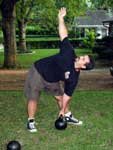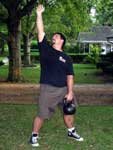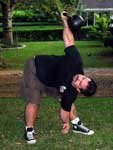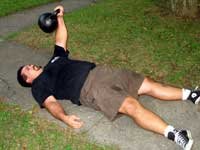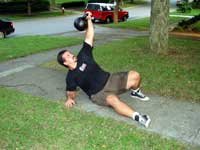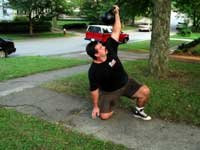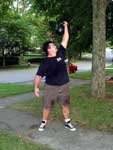| Part 1 | Part 2 | Part 3 |
Last time we looked at the swing and the Janda sit-up, both of which are good for strengthening the core. The swing is also a great conditioning drill for the cardiovascular system.
This time we will look at two exercises that will strengthen the shoulder through a wide range of motion while also working the core.

Windmill

 The windmill is a great exercise for the strength and flexibility of the midsection and lower back, as well as shoulder stability. It can be done with a kettlebell, dumbbell or for a greater challenge, a barbell.
The windmill is a great exercise for the strength and flexibility of the midsection and lower back, as well as shoulder stability. It can be done with a kettlebell, dumbbell or for a greater challenge, a barbell.
There are several variations of the windmill. Here are a few of them.
Low Windmill
This is the beginner way to perform the windmill. It teaches the mechanics of the lift without having the weight overhead. It helps build the proper groove for the more difficult overhead versions.
Stand with your feet slightly wider than your shoulders. Turn one foot out about forty-five degrees and place a weight next to it. Shift most of your weight to the opposite foot by pushing your hip out to the side and put the arm on that side overhead.
Look up at your hand and fold forward at the hips, keeping the back and legs straight, until you reach the weight at your foot. Take hold of the weight with your low hand, squeeze the glutes hard and stand up. Lower the weight in the same groove.
High Windmill
This is the most common way to do the windmill. First get a weight overhead by whatever means you wish, press, snatch, whatever. Lock out your arm and keep it that way. Push your hip out to the side holding the weight and turn your other foot out 45 degrees. Look up at the weight and fold forward at the hips, keeping the back straight, until you reach the limits of your flexibility. Squeeze the glutes hard and follow the same path back to standing.
At first you may lack flexibility to go very far, but eventually touching the floor with the opposite hand is a good goal to have.
High-low Windmill
Finally we have the combination of the high and low versions. Here you will get a weight overhead and perform the high windmill, but you also have a weight next to your foot that you will grab while in the bent position. When you have a grip on the second weight, stand up with both of them, one arm overhead and one arm hanging down. Keep the bottom arm straight, think of a chain with a hook on the end.
Important Tips
- Do not force the range of motion. Increase gradually while staying within your limits.
- Keep the reps low, no more than 5 per side.
- This drill is best practiced outdoors where you can simply drop the weight if you start to lose control.
- Move slowly keeping the back straight.

Turkish Get Up

The Turkish get up is not a costume that makes you look like a character from Arabian Nights. It is a fun drill that is excellent for shoulder stability and flexibility. Once you master it, all other overhead drills will improve. This is an excellent drill for grapplers or anyone who wants functional strength in the entire body.
Exercise Description
Lie on your back and press out a weight. Lock out the arm and think of "punching up" at the top. Bend the leg that is on the same side as the weight and put the foot flat. Pivot to the opposite side and roll up onto your elbow using the strength of your leg and abs.
Straighten the arm and drive yourself up into a lunge position. Keep you eyes on the weight and slowly stand up. Reverse the motion back to the starting position.
Important Tips
- Keep the elbow locked and your eyes on the weight at all times.
- Breathe shallow and keep the abdomen pressurized. When getting up from the lunge, make a quick grunt to get through the sticking point.
- No matter how light the weight is, treat it like it is heavy.
- Keep the forearm vertical at all times.
- Keep the reps low, no more than 5 per side.
- This drill is best practiced outdoors where you can simply drop the weight if you start to lose control.
Adding these two exercises to your arsenal will improve your all-around strength and conditioning, make you a better athlete while getting some strange looks from people in the gym.
About The Author
David Whitley, RKC is a Russian Kettlebell instructor, strength coach and massage therapist in Nashville, TN. He earned his RKC at the June 2003 certification and was an assistant instructor at the April 2004 RKC. On December fourth 2004 he became the first American-born man to achieve CMS rank in Girevoy Sport. He conducts Kettlebell workshops and trains clients privately in the Nashville area.
He is also available for online personalized training and phone consultation. Contact him by email at irontamerdave@hotmail.com, and visit his website: www.irontamer.com.
| Part 1 | Part 2 | Part 3 |


